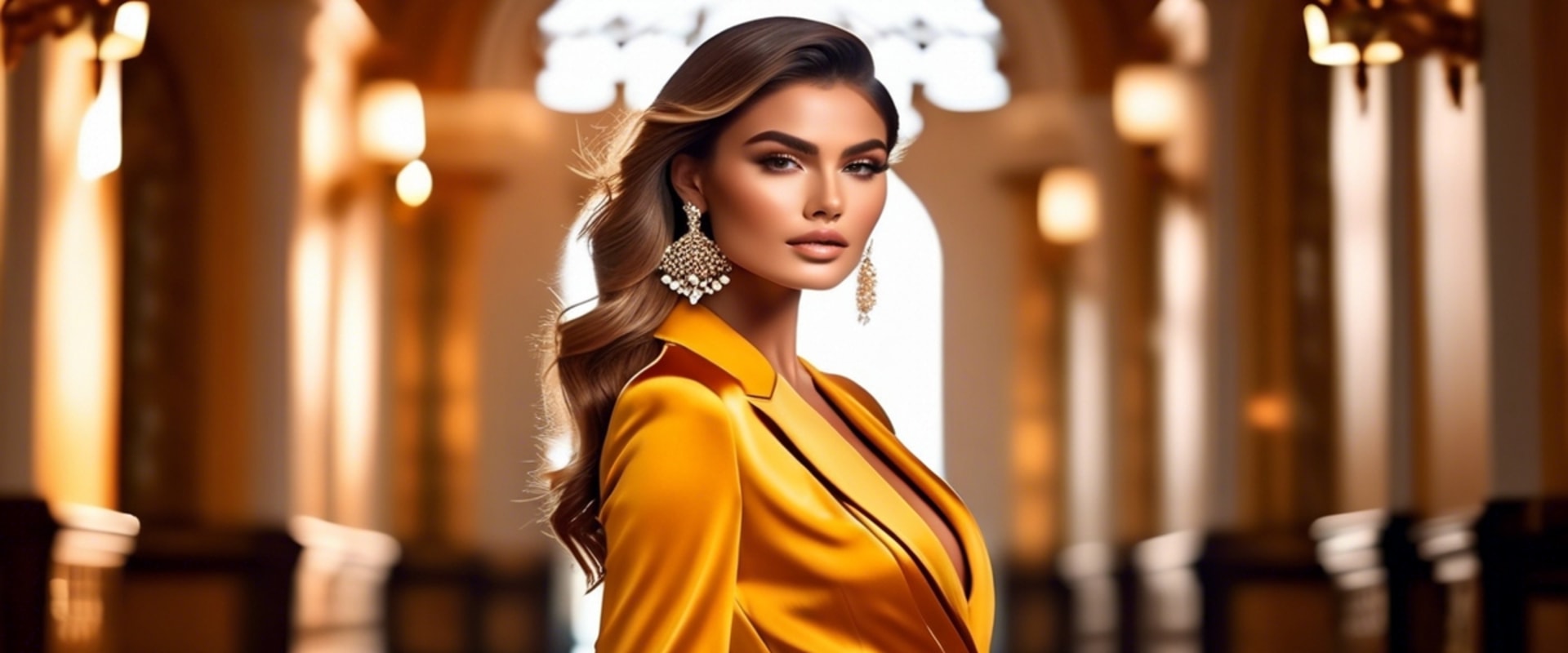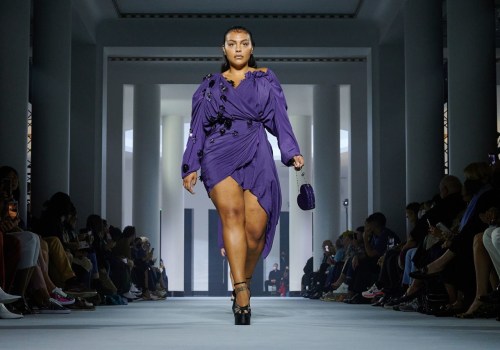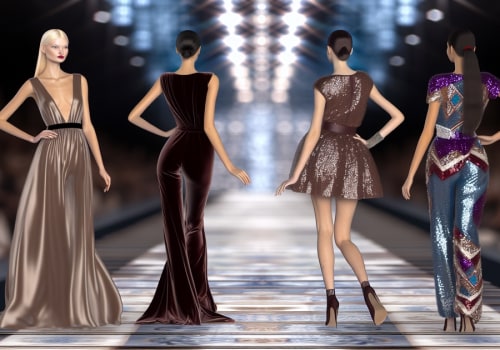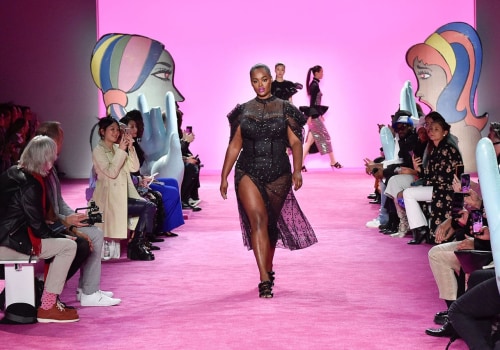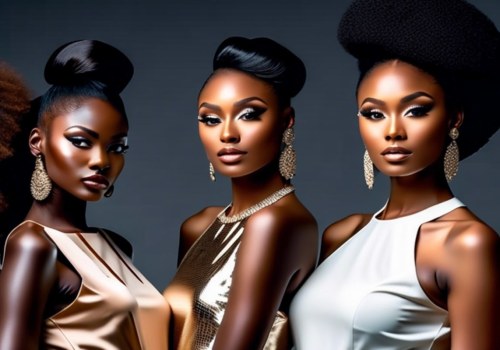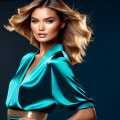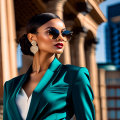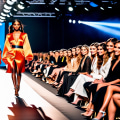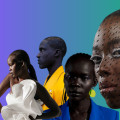Ever wondered what it takes to stride down the catwalk at a fashion show with confidence and grace? Curious about the hidden world behind those captivating fashion shoots, vogue, glamour modelling, and magazines? From mastering diverse poses to understanding the art of expression, fashion modeling is a multifaceted craft that goes beyond just striking a pose.
Whether you're an aspiring model seeking guidance or simply intrigued by the enigmatic world of high fashion, join us as we unravel the mysteries behind successful runway appearances, photoshoots, and vogue. Get ready to explore everything from casting calls to nailing that perfect "smize," as we embark on an exciting journey through the captivating universe of fashion modeling.
Career Overview
Industry Evolution
Fashion modelling has undergone significant changes over the years. Initially, it revolved around posing for photoshoots and strutting down the runway. The industry market is fiercely competitive, but it also presents numerous opportunities for individuals who manage to stand out. Models collaborate closely with designers, photographers, stylists, and magazines to showcase a wide array of clothing and accessories. Achieving success in fashion modelling demands unwavering dedication and resilience.
The evolution of fashion modelling has been remarkable as it has transitioned from traditional catwalk shows to embracing digital platforms. With the advent of social media and magazines, models now have an entirely new way of connecting with their audiences. This shift has not only altered how models engage with their followers but also transformed the dynamics of brand promotion within the industry.
In addition to these transformations, one cannot overlook the increasing inclusivity within fashion modelling and magazines. The industry now celebrates diversity by embracing various body types and backgrounds that were previously underrepresented or overlooked in magazines. Moreover, technological advancements have completely revolutionised how models are discovered and promoted in today's digital age.
One notable example is the rise of Instagram models who have gained fame solely through their presence on this platform without conforming to conventional standards set by traditional agencies.
Modelling Types
Fashion modelling encompasses a broad spectrum that extends beyond its traditional roots into an era dominated by digital platforms like social media. It's no longer just about walking down runways; instead, it involves creating engaging content across various online channels such as Instagram, TikTok, YouTube etc., which allows models to connect directly with their audience.
Social media’s impact on fashion modelling cannot be overstated - it has redefined how brands interact with consumers while giving models unprecedented access to global audiences without relying solely on agencies or established connections within the industry.
Another significant change lies in embracing diversity within fashion modeling - gone are the days when only a specific body type was celebrated; today's industry welcomes all shapes and sizes along with different ethnicities and cultural backgrounds.
Technological advancements have played a pivotal role in reshaping modern-day model scouting processes – where once scouts relied heavily on physical appearances at events or through agencies' submissions alone - they can now use social media platforms like Instagram or TikTok as effective tools for discovering fresh talent.
Future Prospects
The future prospects for careers in fashion modeling appear promising due to ongoing shifts towards inclusivity driven by societal changes alongside rapid technological advancements that continue shaping this dynamic field. Prospective talents will find themselves navigating an environment where creativity meets technology head-on while adapting seamlessly between traditional catwalk presentations and innovative digital campaigns. With brands increasingly seeking authenticity over conventional beauty standards coupled with diverse representation becoming more prevalent across advertising campaigns globally. This paves exciting pathways for aspiring individuals looking to venture into this ever-evolving arena.
Entering the Fashion Industry
Modelling Requirements
Fashion modelling encompasses various types, including runway, editorial, commercial, and plus-size. Each type demands distinct skills and appeals to specific audiences. For instance, runway models need to master the art of walking gracefully in high heels and projecting confidence. On the other hand, commercial models must excel at showcasing everyday products in a relatable manner. Understanding these nuances is crucial for success in fashion modelling.
Models often specialise in one type of modelling but may also work across multiple categories to diversify their portfolio and career opportunities. For example, a model might primarily focus on editorial work for fashion magazines while occasionally taking on commercial projects for clothing brands or beauty products.
Agency Expectations Height, measurements, and overall appearance play a significant role in meeting agency requirements for fashion modelling. Models are generally expected to meet specific height and body measurement criteria based on the type of modeling they pursue. Clear skin, healthy hair, and a fit physique are essential attributes sought after by agencies across all types of fashion modelling.
In addition to physical attributes, maintaining physical fitness is an ongoing requirement as it contributes significantly to a model's overall appearance and ability to perform various poses or movements during photoshoots or runway shows.
Professionalism plays a vital role in fulfilling agency expectations within the fashion industry. Punctuality when attending castings or fittings is key as it reflects reliability – an attribute highly valued by agencies seeking professional conduct from their models.
Specialised Fields Agencies expect models not only to maintain their physical appearance according to industry standards but also adhere strictly to instructions regarding appointments such as castings or fittings. This level of commitment demonstrates professionalism while building trust between models and agencies. Building a strong portfolio is crucial for success in fashion modelling as it showcases a model's versatility across different styles of photography or runway presentations. Furthermore, actively promoting oneself through social media platforms can help models gain visibility within the industry by reaching potential clients or collaborators directly.
Building a Modelling Career
Skills Development
Fashion modelling encompasses various specialised fields, including fitness modelling, lingerie/swimwear modelling, and alternative fashion. Models can also carve out niches in hand or foot modelling, each requiring unique skills tailored to the specific market segment. For instance, fitness models need to possess a toned physique and exude an aura of health and vitality. On the other hand, lingerie/swimwear models must master poise and confidence while showcasing these types of garments. Success in these areas, hinges on a deep understanding of the target audience's preferences.
Furthermore, success in the modeling world often demands continuous skill development as trends evolve. Aspiring models should stay abreast of industry developments and emerging fashion styles to remain relevant within their chosen niche. This could involve attending workshops or seeking mentorship from established professionals in their field.
In addition to physical attributes and technical abilities, effective communication is pivotal for career advancement within the modelling industry. Models must collaborate closely with photographers, stylists, and clients to bring creative visions to life during photoshoots or runway shows. Clear articulation of ideas ensures that everyone involved is aligned towards achieving desirable outcomes.
Lastly, confidence plays an integral role in career progression for aspiring models entering the competitive modeling world. Whether it's exuding charisma on the runway or presenting oneself professionally during castings or client meetings - self-assuredness is key.
Career Progression
Developing posing techniques is crucial for capturing diverse looks in photoshoots across different genres such as editorial shoots or commercial campaigns. Each style necessitates distinct poses that convey varying emotions or themes effectively.
Moreover, strong communication skills are vital when working with photographers and stylists; this includes understanding directions clearly whilst adding personal flair where appropriate without overshadowing the primary vision.
Confidence not only impacts how well a model presents themselves but also influences how they perform under pressure both on stage during fashion shows as well as behind-the-scenes at auditions and fittings.
Continuous learning about current fashion trends allows models to adapt their style according to prevailing tastes while staying ahead of shifts within the industry landscape.
Day-to-Day Model Life
Routine Tasks
Aspiring models often start with local gigs, such as small-scale fashion shows or photo shoots for local brands. This initial phase allows them to gain experience and build their portfolio before progressing to national or international opportunities. Successful models may transition into mentoring roles, sharing their expertise with newer talents, or pursue entrepreneurial ventures within the industry by launching their own fashion lines or beauty products.
Building a strong personal brand is crucial for models as it can lead to various career extensions such as endorsements, acting roles in commercials or films, and other lucrative opportunities. Moreover, career progression often involves diversifying skills and adapting to changing industry demands. For instance, a model may learn additional skills like public speaking to excel in brand ambassador roles or develop expertise in social media management to enhance their online presence.
Work Environment
Fashion modelling offers a dynamic work environment that varies from day to day. Models might find themselves on location for outdoor photo shoots one day and walking the runway at a high-profile event the next. The diversity of assignments keeps the job interesting but also requires adaptability and versatility from the models.
Opportunities Abound The world of fashion modelling presents numerous opportunities beyond traditional runway shows and photoshoots. Models may participate in product launches, brand collaborations, influencer marketing campaigns, and even television appearances. These diverse opportunities allow models to showcase their talent across different platforms while expanding their professional network.
Earnings Insights In the early years of a modeling career, earnings can be modest as aspiring models establish themselves within the industry through smaller gigs and projects. However, successful individuals who secure contracts with renowned brands or designers can command substantial earnings per assignment due to their established reputation.
Decade Transformations The field of fashion modelling has witnessed significant transformations over decades with changes in trends reflecting societal shifts. From supermodels dominating magazine covers in the 1990s to today's emphasis on inclusivity and diversity on runways – these shifts have redefined what it means to be a successful model while opening doors for talents from various backgrounds.
Niche Opportunities Within fashion modelling exist niche segments catering specifically towards areas like plus-size modelling, petite modeling (for shorter individuals), fitness modeling focusing on athletic physique promotion etc., allowing individuals with distinct attributes an avenue into this competitive industry.
The UK Modelling Scene
Opportunities Abound
Fashion modelling in the United Kingdom offers a plethora of opportunities for aspiring models. From runway shows and photo shoots to brand collaborations and international exposure, the industry presents a diverse landscape for individuals with a passion for fashion and creativity. Aspiring models need to understand that success in this field demands dedication, adaptability, and continuous learning. Embracing the evolving nature of fashion is crucial as trends shift rapidly, requiring models to stay updated and versatile.
Entering the world of fashion modelling requires more than just striking looks; it demands honing essential skills such as posing techniques, understanding body movement, facial expressions, and maintaining physical fitness. Models must also develop strong interpersonal skills to collaborate effectively with photographers, designers, stylists, and other professionals within the industry.
Moreover, embracing technological advancements is vital as social media plays an increasingly significant role in shaping a model's career. Building a personal brand through platforms like Instagram can significantly impact visibility within the industry. Therefore, staying informed about digital marketing strategies becomes essential for long-term success.
Navigating through auditions can be challenging but persistence pays off in this competitive field. Models should be prepared to face rejections while continuing to refine their craft. By fostering resilience and determination alongside talent development efforts, individuals can carve out fulfilling careers in fashion modelling while contributing meaningfully to the dynamic world of fashion and entertainment.
Earnings Insights
In terms of earnings potential within fashion modelling, it varies widely based on factors such as experience level, type of work (e.g., runway vs commercial), location (e.g., London vs smaller cities), endorsements or contracts with brands or agencies etc.
Pros:
Successful high-fashion models have immense earning potential through lucrative contracts with renowned brands.
Runway shows during major fashion weeks offer substantial payoffs.
Endorsements from luxury brands often come with generous compensation packages.
Cons:
For beginners or those without established reputations yet, consistent income may be unpredictable due to irregular bookings.
The pressure associated with meeting specific beauty standards might lead some individuals towards unhealthy practices.
Understanding these dynamics is crucial for aspiring models aiming at sustainable financial stability within this profession.
Historical Context of Modelling
Early Years
Fashion modelling has a rich historical background, dating back to the early 20th century. In the 1920s, iconic figures like Audrey Munson and Evelyn Nesbit gained fame as fashion models. These women were celebrated for their elegance and style, setting the stage for modern fashion modelling. The emergence of haute couture in Paris during this time propelled the need for models to showcase designer creations.
The concept of fashion modelling continued to evolve throughout the mid-20th century. With the rise of international fashion houses like Chanel and Dior, there was an increasing demand for models who could embody sophistication and luxury. This era witnessed the birth of supermodels such as Twiggy and Jean Shrimpton, whose distinctive looks redefined beauty standards in fashion.
In addition to being trendsetters on runways, these early models became cultural icons, influencing hairstyles, makeup trends, and even social norms. Their influence extended beyond just wearing clothes; they embodied an entire lifestyle that captivated audiences worldwide.
Decade Transformations
The world of fashion modelling experienced significant transformations during different decades. In the 1960s, '70s,'80s,'90s up until today's digital age have each left their mark on this industry.
During the swinging sixties' era marked by social change and liberation movements', fashion took a bold turn with unconventional styles that challenged traditional norms. Models like Veruschka von Lehndorff embraced avant-garde looks that reflected a shifting societal landscape where individuality was celebrated.
Moving into the '70s brought about a more diverse representation in modelling, with African-American models such as Beverly Johnson breaking barriers within an industry previously dominated by white faces. This shift paved way for greater inclusivity in later years.
As we entered into the high-octane '80s era characterized by power dressing and glamourous aesthetics', supermodels emerged as global sensations; names like Cindy Crawford and Naomi Campbell became synonymous with success in both fashion modeling careers.
By stepping into contemporary times -the '90s saw grunge culture infiltrate mainstream fashion'. Kate Moss rose to prominence with her non-conventional look which defied conventional standards'. Her waif-like figure sparked discussions around body image within media.
Fast forward to today's digital age –social media platforms have revolutionized how aspiring individuals can break into modelling, challenging traditional agency-based approaches.
The Specialised Modelling Fields
Niche Opportunities
Fashion modelling encompasses a wide array of specialised fields, offering niche opportunities for models to showcase their unique talents. From haute couture and runway modelling to catalogue and fit modeling, each niche requires specific skills and attributes. For instance, haute couture modelling demands the ability to exude elegance and grace while showcasing high-end designer clothing on the catwalk. On the other hand, fit models work behind the scenes with designers, providing precise measurements for garments during the production process. These diverse niches within fashion modelling allow individuals to find their own path based on their strengths and interests.
In addition to traditional runway or print work, there are also emerging opportunities in areas such as petite or plus-size modelling. Petite models typically stand at 5'3" or under, offering a unique perspective in an industry often dominated by taller individuals. Plus-size models challenge conventional beauty standards by representing a more inclusive range of body types in fashion campaigns and editorials. These niche opportunities not only cater to a broader audience but also promote diversity and inclusivity within the fashion industry.
Furthermore, there are specialized fields like lingerie or swimsuit modelling that require confidence, poise, and comfort with revealing attire. Models working in these niches need to possess a strong sense of self-assuredness while maintaining professionalism during shoots or shows.
Field Requirements
Each specialised field within fashion modeling comes with its own set of requirements tailored to its unique demands. While traditional runway models may need to meet certain height criteria (typically around 5'9" - 6'0"), fit models must maintain specific body proportions that accurately represent standard sizing used by designers.
Moreover, aspiring fashion models should focus on building a versatile portfolio that showcases their ability across various mediums such as print ads, editorial spreads, e-commerce platforms etc., which can help them secure diverse assignments across different niches.
Furthermore, physical fitness, good posture, and an understanding of posing techniques are essential for most forms of fashion modeling. However, commercial modeling, which includes advertising campaigns for products ranging from household items to cosmetics, may require less stringent physical attributes compared with high-fashion modeling.
Essential Skills for Models
Industry Skills
To succeed in fashion modelling, models need to possess a range of industry-specific skills. Firstly, photographic posing is crucial as it helps models understand how to position their body and face optimally for the camera. This skill involves mastering various poses that showcase clothing or accessories effectively. runway walking is another essential skill for fashion models. They must learn to walk confidently on different types of runways while maintaining poise and grace. For example, female models need to perfect their runway walk, ensuring they exude confidence and elegance.
Furthermore, having a good understanding of clothing styling can be beneficial for fashion models as it allows them to provide valuable input during photoshoots or runway shows. This includes knowing how different fabrics drape and move, as well as being aware of current fashion trends. Moreover, possessing basic knowledge about hair and makeup techniques can also be advantageous for models. Understanding how different makeup looks are applied and how certain hairstyles complement specific outfits enables them to adapt quickly to various styling requirements.
In addition to these practical skills, an understanding of the business side of modelling is vital too. Models should have a grasp on concepts such as contracts negotiation, professional etiquette at castings or shoots, and the ability to work with diverse teams in high-pressure environments.
Personal Attributes
Aside from industry-specific skills, there are several personal attributes that contribute significantly towards success in fashion modelling. Confidence plays a pivotal role in this field; being comfortable in one's own skin is essential when constantly being scrutinised by clients or audiences during photoshoots or catwalk appearances.
Moreover, resilience is crucial due to the competitive nature of the industry; facing rejection regularly requires mental strength so that it doesn't impact performance negatively over time.
Another important attribute is adaptability; given the fast-paced nature of fashion shows and shoots where last-minute changes are common occurrences - including wardrobe alterations or revised schedules - flexibility becomes key for successful navigation through such scenarios without causing unnecessary disruptions.
Furthermore, professionalism, which encompasses punctuality, reliability, and respectfulness, is highly valued within the modeling community. This trait not only fosters positive working relationships but also contributes towards building a reputable image within the industry.
Lastly, networking abilities, especially among female models looking at establishing themselves within this field, could potentially open doors leading to new opportunities. Cultivating strong connections with designers, fellow models, and industry professionals can lead to future collaborations and career advancements.
Agency Expectations Unveiled
Desired Qualities
Agencies have specific expectations when scouting for new talent. One of the most desired qualities in a model is versatility. Models who can effortlessly transition from high fashion editorials to commercial catalogues are highly sought after. This means being able to adapt one's look and style to suit the diverse needs of different clients.
Another essential quality that agencies look for in models is confidence. Confidence not only exudes on the runway or during photoshoots but also plays a crucial role in casting sessions and client interactions. Models need to feel comfortable in their own skin, be at ease with various poses, and project confidence through their body language.
Furthermore, having a positive attitude is paramount for success in the fashion modelling industry. Agencies seek models who are professional, punctual, and easy to work with. A positive attitude can make all the difference during long hours on set or while navigating challenging situations behind the scenes.
Models must also possess adaptability as they often encounter unpredictable circumstances during assignments. Whether it's adjusting to last-minute wardrobe changes or working in different weather conditions, being adaptable is key for thriving as a fashion model.
Portfolio Significance
A model's portfolio serves as their visual resume and plays an integral role in securing bookings with top clients and agencies alike. It should showcase a diverse range of looks, styles, moods, expressions, and poses that highlight the model's versatility.
Including both headshots and full-body shots allows agencies to gauge how well-rounded a model's portfolio is. For instance:
Headshots: These close-up shots focus primarily on the face and hair; they help demonstrate facial features such as bone structure, eyes, lips etc.
Full-body Shots: These shots display the overall physique of the model along with their posing abilities; they allow clients to assess posture, body proportions etc.
In addition to variety within individual images (different hairstyles/makeup/wardrobe), diversity across images (different settings/lighting/backgrounds) further enhances portfolio significance by showcasing adaptability.
Moreover, professionalism reflected through high-quality images captured by reputable photographers adds credibility to a model’s portfolio - this signals commitment towards building a successful career within fashion modelling.
Stepping into Modelling
Getting Started
So, you're considering a career in fashion modelling. The first step is to decide what type of modelling interests you the most. There are various categories such as glamour modelling, fitness modelling, and catwalk or runway modelling. Each has its own unique requirements and opportunities.
If glamour and beauty are your forte, then glamour modelling might be the right fit for you. This genre focuses on capturing the allure of beauty through captivating poses and expressions, often seen in magazines or advertisements.
On the other hand, if you have a passion for fitness and leading a healthy lifestyle, then pursuing a career in fitness modelling could be ideal for you. Fitness models often showcase activewear, demonstrate exercise routines, or promote health products.
For those who thrive under the spotlight with confidence and grace, walking the catwalk as a fashion model might be your calling. Embracing this path would involve strutting down runways showcasing designer clothing at fashion shows or events.
Once you've identified your area of interest within fashion modeling, it's essential to build your portfolio by collaborating with photographers to capture diverse looks that highlight your versatility as a model.
In addition to building your portfolio, consider approaching reputable agencies specialising in different types of modeling such as glamour or fitness modeling based on your preference.
When seeking representation from an agency specializing in specific genres like glamour or fitness modeling can provide valuable guidance tailored to each category's unique demands.
Success Tips
Success in the world of fashion modeling requires more than just striking good looks; it demands dedication, perseverance, and professionalism.
One key success tip is maintaining physical fitness by adopting regular exercise routines and following balanced diets that align with industry standards for body shape and size.
Another crucial aspect is honing not only physical but also mental well-being - developing resilience against rejections while staying motivated throughout auditions.
Moreover, magazine-quality photoshoots require models to master posing techniques that convey emotions effectively while being comfortable under lights during extended sessions.
Furthermore, catwalk models should practice their walk regularly – mastering poise combined with fluid movements which captivate audiences during high-profile events like Fashion Week showcases.
Career Outlook for Models
Employment Trends
The fashion modelling industry has witnessed significant shifts in employment trends over the past few years. With the rise of social media and influencer culture, there's been an increasing demand for models who not only possess striking looks but also have a strong online presence. This means that aspiring models need to focus on building a robust personal brand across various digital platforms such as Instagram, TikTok, and YouTube. Companies often seek models with a substantial following to leverage their influence for marketing purposes.
Moreover, the fashion industry is increasingly embracing diversity and inclusivity. Brands are actively seeking models from different ethnicities, body types, and gender identities to represent their products. This shift towards inclusivity has opened up opportunities for individuals who may not fit traditional beauty standards but still exude confidence and charisma.
On the downside, competition within the fashion modelling sector remains fierce. Aspiring models face intense competition at castings and auditions due to the sheer volume of hopefuls vying for limited spots. Many companies now opt for influencer collaborations rather than traditional model hires because influencers come with built-in audiences.
In terms of job stability, freelance modelling gigs are becoming more common than long-term contracts with agencies or brands. While this offers flexibility in scheduling and project selection, it also means that income can be irregular and unpredictable.
Longevity in Modelling
It's essential to understand that careers in this field can be relatively short-lived compared to other professions. The typical career span of a model ranges from just a few years to around a decade or so.
Factors such as age restrictions imposed by certain segments of the industry can significantly impact how long one can sustain their career as a model. For instance, high fashion runways tend to favour younger talent while commercial advertising may offer more opportunities for older individuals.
Moreover, physical appearance plays a crucial role in determining how long an individual can remain active as a model. As people age or undergo changes in physique due to pregnancy or lifestyle choices like weight gain or loss, they may find themselves less sought after by clients looking for specific aesthetics.
Despite these challenges related to longevity and sustainability within the industry, some successful models have managed extended careers through diversification into areas such as acting or entrepreneurship within fashion-related ventures.
Final Remarks
You've now gained a comprehensive understanding of the fashion modelling industry, from its historical roots to the essential skills and day-to-day tasks of a model. As you step into the world of fashion modelling, remember that success in this field demands perseverance, adaptability, and a strong work ethic. Embrace opportunities, stay updated with industry trends, and continuously hone your skills to carve out a fulfilling career as a fashion model.
So, go ahead and strut confidently into the world of fashion modelling, armed with the knowledge and insights you've acquired. Keep pushing your boundaries, stay passionate about your craft, and always be open to learning and growing. The fashion modelling industry is waiting for your unique flair and talent! Good luck on your exhilarating journey!
Frequently Asked Questions
What are the essential skills required for a career in fashion modelling?
To excel in fashion modelling, you need impeccable posture, versatility, and the ability to take direction well. Strong interpersonal skills and resilience are also crucial for navigating the competitive industry.
How can I enter the world of fashion modelling?
Entering the fashion modelling industry requires determination and self-confidence. Start by building a professional portfolio and attending open casting calls or contacting reputable agencies to kickstart your career.
What is the working environment like for fashion models in the UK?
Fashion models in the UK work in diverse settings, including studios, runways, and on-location shoots. They often collaborate with photographers, stylists, and makeup artists while adapting to varying schedules and environments.
What do modelling agencies typically look for in aspiring models?
Modelling agencies seek individuals with unique features, strong work ethic, professionalism, adaptability to different roles or looks. Confidence coupled with humility goes a long way as it's not just about appearance but also attitude.
How has the historical context shaped modern-day fashion modelling?
The evolution of fashion modelling from its early years has been influenced by societal changes, technological advancements, and shifts in beauty standards. These factors have collectively moulded contemporary perceptions of beauty within this dynamic industry.
Fashion Modelling: Requirements and Restrictions
Physical Attributes
To pursue a career in fashion modelling, there are specific physical attributes that agencies and clients typically look for. These include height, weight, body measurements, and overall appearance. For instance, female models are often expected to be between 5'8" to 6'0" tall, with measurements around 34-24-34 inches. Male models generally range from 5'11" to 6'3", with well-defined features and a toned physique.
Fashion modelling also places emphasis on clear skin, healthy hair, good posture, and the ability to move gracefully. While these standards have evolved over time to embrace diversity, certain physical requirements remain essential within the industry.
Age Restrictions
In the world of fashion modelling, age plays a crucial role. Most aspiring models start their careers in their mid-teens or early twenties when they're still growing into their adult proportions but not too young that it raises ethical concerns about exploitation or inappropriate content creation.
There's a delicate balance between being old enough to handle the demands of the industry professionally while still maintaining a youthful appearance that resonates with fashion brands and consumers alike. However, as models gain experience and establish themselves in the industry, some find success at more mature ages due to demand for seasoned professionals who exude confidence and sophistication.
Health Considerations
Maintaining good health is paramount for individuals pursuing careers in fashion modelling. This includes following a balanced diet tailored to support energy levels required for long hours during shoots or runway shows while keeping body weight within acceptable limits set by agencies or clients.
Models need regular exercise routines not only for staying fit but also for developing muscle tone necessary for showcasing garments effectively. Furthermore, mental well-being is equally important; coping with stress from hectic schedules or dealing with rejection requires resilience.
Career Path and Progression in Fashion Modelling
Education and Training
To embark on a career in fashion modelling, it's essential to consider formal training, such as enrolling in reputable modelling schools or academies. These institutions provide valuable lessons on posture, runway techniques, posing, skincare, makeup application, and hair styling. Obtaining a diploma or degree in fashion design can offer insights into the industry's dynamics. Understanding garment construction and textile selection can enhance a model's ability to showcase various clothing designs with confidence.
Attending workshops hosted by seasoned models or agencies is another beneficial avenue for learning the intricacies of fashion modelling. These sessions often cover topics like brand representation, networking strategies, and portfolio development. Furthermore, gaining proficiency in dance or other forms of performing arts can contribute to mastering body movement and expression.
It's important to note that while education provides a strong foundation for aspiring models, practical experience gained through auditions and actual photo shoots remains invaluable.
Building a Portfolio
A crucial aspect of advancing in fashion modelling involves assembling an impressive portfolio that showcases versatility across different styles and settings. This collection typically includes professional photographs capturing diverse poses and moods while wearing various outfits – from casual wear to haute couture pieces. Collaborating with talented photographers allows models to curate captivating images that exhibit their potential as versatile assets within the industry.
Participating in test shoots with emerging photographers helps expand one's portfolio without relying solely on paid assignments from established brands or publications. Moreover, engaging with makeup artists, stylists, and hairstylists during these collaborative projects aids in broadening one's network while honing skills required for editorial spreads or commercial campaigns.
In addition to visual content creation for portfolios, creating video reels showcasing runway walks at fashion shows or behind-the-scenes footage from photo shoots adds depth to an aspiring model’s promotional material.
Securing Representation
Acquiring reliable representation through reputable modeling agencies significantly propels fashion modelling careers forward. Agencies serve as intermediaries between models and clients by securing bookings for runway shows, magazine editorials, and advertising campaigns. Joining forces with an agency grants access to casting calls organised by renowned designers seeking talent for their collections' presentations during major fashion weeks worldwide. Moreover, these establishments provide guidance on contract negotiations, financial management, and image cultivation. While signing exclusively with an agency offers stability, some models opt for non-exclusive contracts allowing them the flexibility to pursue independent opportunities.
How to Become a Fashion Model
Education and Training
To pursue a career in fashion modelling, formal education isn't always necessary, but it can be beneficial. Many successful models have completed high school and some even hold college degrees. While academic qualifications aren't mandatory, they can provide valuable skills such as communication, critical thinking, and time management. Aspiring models may consider enrolling in modelling classes or workshops to learn about posing techniques, runway walking, and skincare routines.
Attending these classes helps individuals understand the industry's expectations and develop essential skills for success. Furthermore, obtaining training from reputable agencies or experienced professionals can offer insights into the competitive world of fashion modelling. These opportunities also allow aspiring models to network with industry insiders who may provide guidance on navigating the field.
In addition to formal education and training programmes, gaining practical experience is crucial for honing one's craft as a model. This involves participating in local fashion shows or photo shoots to build a portfolio that showcases versatility in different styles of clothing and poses. By doing so, aspiring models not only gain exposure but also demonstrate their dedication and passion for the profession.
Moreover, staying updated on current fashion trends through magazines, social media platforms like Instagram or Pinterest is vital for understanding what's popular in the industry.
Physical Requirements
Physical appearance plays a significant role. Typically tall stature (for example 5'8" - 6'0"), well-proportioned body measurements (such as 34-24-34), clear skin with minimal blemishes are often sought after by agencies looking for potential models.
While adhering strictly to these standards isn't always necessary due to evolving beauty norms within the industry; maintaining good physical health is crucial regardless of specific requirements set by agencies or clients. Regular exercise combined with a balanced diet contributes not only to physical fitness but also overall well-being which reflects positively during auditions or photoshoots.
It's important for aspiring models not to compromise their health just to fit certain body standards set by the industry; embracing individuality while striving towards personal fitness goals is key.
Building Your Portfolio
As an aspiring fashion model, building an impressive portfolio is essential when seeking representation from modelling agencies or applying directly for gigs at casting calls. A strong portfolio should include diverse images that showcase various looks – ranging from casual wear shots to high-fashion editorial poses.
Collaborating with professional photographers can help create striking images that capture different moods and styles suitable for commercial work as well as haute couture assignments. Additionally, maintaining an active presence on social media platforms like Instagram enables prospective employers – including designers, photographers, and brands –to discover your work easily. Sharing professional photoshoots alongside behind-the-scenes glimpses offers insight into your personality while demonstrating your commitment towards pursuing a career in fashion modeling.
By following these steps, aspiring individuals can lay down strong foundations towards establishing themselves within the competitive realm of fashion modeling.
Skills and Knowledge for Fashion Modelling
Physical Fitness
To excel in fashion modelling, maintaining good physical fitness is crucial. Models need to have a healthy body weight, toned muscles, and excellent posture. Regular exercise routines that include cardio, strength training, and flexibility exercises are essential. For example, running, yoga, or Pilates can help models stay in top physical condition.
Models also need to focus on maintaining a balanced diet to keep their bodies healthy and fit for the demands of the industry. Consuming plenty of fruits and vegetables while avoiding excessive processed foods is vital. Staying hydrated by drinking plenty of water plays a significant role in sustaining overall health and glowing skin.
Adequate rest is equally important for fashion models as it contributes to their overall well-being. Getting enough sleep allows the body to recover from strenuous workouts and long hours spent at work.
Confidence
Confidence is an indispensable trait for fashion modelling success. Models must exude self-assurance both on the runway and during photoshoots. They should be comfortable with themselves regardless of external opinions or criticisms.
Developing confidence often involves practising positive affirmations daily to boost self-esteem levels continuously. Engaging in activities such as public speaking or acting classes can also aid in building confidence by honing presentation skills.
Furthermore, having a strong sense of self-awareness helps models project confidence effortlessly when they're under the spotlight.
Adaptability
The world of fashion modelling is fast-paced. Therefore, adaptability becomes an essential skill for success within this industry. Models must be open-minded about trying new styles and trends while being able to adjust quickly to different environments or unexpected changes during shoots or shows.
Adaptability also means being receptive to feedback from photographers, designers, stylists, etc., which enables them to constantly improve their performance based on constructive criticism received.
Maintaining professionalism even under pressure showcases adaptability too - remaining calm during hectic schedules demonstrates this trait effectively.
Day-to-day Tasks of a Fashion Model
Runway Shows
Fashion models frequently participate in runway shows, where they showcase the latest clothing designs. They spend hours practicing their walks, perfecting their posture, and learning to exude confidence on the catwalk. During fashion weeks, models may walk for multiple designers in a single day, requiring them to swiftly change outfits and maintain composure despite hectic schedules.
Runway shows demand precision and adaptability from fashion models. They must seamlessly transition between various looks while embodying the essence of each designer's collection. For instance, at New York Fashion Week, a model might start her day walking for Michael Kors' classic American sportswear line before quickly changing into an avant-garde creation by Marc Jacobs.
The fast-paced nature of runway shows necessitates utmost professionalism from fashion models as they navigate through different settings and styles with poise and grace.
Photoshoots
Another integral part of a fashion model's routine is participating in photoshoots for magazines, catalogues, or online campaigns. These shoots involve collaborating with photographers, stylists, hairdressers, and makeup artists to bring specific concepts or products to life through visual storytelling.
Fashion models must be adept at conveying emotions and narratives with their body language and facial expressions during photoshoots. Whether it's capturing the carefree spirit of summer for a beachwear campaign or embodying elegance for a high-fashion editorial spread, models play an essential role in translating the vision of the creative team into captivating imagery.
For example: A fashion model might work on diverse projects such as shooting editorials for Vogue magazine one week followed by posing for an international cosmetics brand’s advertising campaign the next week.
Casting Calls & Auditions
In addition to runway shows and photoshoots, casting calls form another crucial aspect of a fashion model's daily activities. Models attend auditions where they present themselves to potential clients seeking individuals who fit particular criteria like height or specific look requirements.
Casting directors often seek versatility when selecting models who can effortlessly embody different aesthetics ranging from commercial appeal to high-end couture elegance. Therefore, aspiring fashion models need resilience as rejection is common in this competitive industry; securing roles involves facing numerous auditions before landing significant opportunities.
Attending casting calls also entails maintaining physical appearance according to industry standards—this includes keeping skin clear and healthy while ensuring one’s physique remains toned yet not overly muscular.
Working Environment for Fashion Models
Varied Settings
Fashion models work in a variety of settings such as studios, fashion shows, and outdoor locations. In studios, they pose for photographers or walk the runway during fashion events. Outdoor photoshoots can take place in urban areas or natural landscapes to capture different moods and styles.
Fashion models also frequently travel to attend casting calls, fittings, and various events related to the industry. They may need to adapt quickly to different environments based on the specific requirements of each assignment.
Opportunities for Fashion Models in the UK
Types of Modelling
Fashion modelling in the UK encompasses various types, including runway, commercial, editorial, and plus-size modelling. Runway models showcase designer clothing on catwalks during fashion shows. Commercial models feature in advertisements for everyday products. Editorial models work for magazines and high-end designers to display current trends and styles. Plus-size modelling focuses on representing larger body sizes within the fashion industry.
Fashion modelling offers diverse opportunities that cater to different body types and styles. For instance, plus-size modelling has gained prominence in recent years as a way to promote body positivity and inclusivity within the industry.
The demand for different types of modelling reflects the evolving standards of beauty and style within society. This creates space for individuals with unique looks or characteristics to find their niche within the fashion world.
Career Growth
Aspiring fashion models can grow their careers by securing representation from reputable agencies, building a strong portfolio, networking with industry professionals, attending casting calls, and maintaining a professional image both online and offline.
Securing representation from established agencies provides access to a wider range of opportunities such as international contracts with renowned brands or participation in major fashion events like London Fashion Week.
Building a strong portfolio involves collaborating with professional photographers to create visually compelling images that showcase versatility across different styles and settings.
Networking is crucial as it allows aspiring models to connect with photographers, designers, stylists, makeup artists, and other key figures who can open doors to new projects or collaborations.
Financial Rewards
Successful fashion models, especially those working at an international level or representing high-end luxury brands through campaigns or runway shows can earn substantial incomes through lucrative contracts.
The financial rewards associated with successful careers in fashion modelling extend beyond monetary compensation alone; they also include exposure opportunities that lead to endorsements deals with leading brands across various industries such as cosmetics or lifestyle products.
Early Years of Fashion Modelling Industry
Evolution of Fashion Modelling
Fashion modelling has undergone a remarkable evolution over the years. In the early 20th century, fashion models were predominantly used in magazines and newspapers to showcase clothing and accessories. These models were often associated with department stores or specific designers, and their primary role was to present garments in a static manner for print media.
This traditional approach began to shift in the mid-20th century when fashion shows became more prevalent. Models started walking down runways, allowing audiences to see how garments moved and flowed on real people. This marked a significant transition from still imagery to dynamic presentations, giving rise to the concept of "catwalk" modelling.
The late 20th century witnessed another revolutionary change with the emergence of supermodels like Cindy Crawford, Naomi Campbell, and Linda Evangelista. These iconic figures transcended traditional boundaries by becoming global celebrities, reshaping the industry's landscape by elevating models' status from mere clothes hangers into influential trendsetters.
Impact on Society
The influence of fashion modelling extends beyond just clothing; it permeates various aspects of society. By representing diverse body types, ethnicities, and styles on international platforms such as London Fashion Week or Paris Fashion Week, fashion models contribute significantly towards promoting inclusivity within the industry.
Moreover, these models act as cultural ambassadors who help disseminate trends worldwide. Their appearances in high-profile events not only shape consumer preferences but also reflect societal values at different points in time. For instance, during periods where environmental sustainability gains prominence globally, there is an observable shift towards eco-friendly fashion choices among both designers and models alike.
Furthermore - through their social media presence - modern-day fashion icons are able to directly engage with their followers across various demographics around issues like body positivity or mental health awareness.
Technological Advancements
In recent decades technological advancements have revolutionized fashion modelling, fundamentally altering how brands market their products while providing new opportunities for aspiring talent. Social media platforms have democratised access enabling anyone with an internet connection can become a model by building a strong online presence showcasing personal style or unique looks. Additionally virtual reality (VR) technology has opened up entirely new avenues for experiencing fashion shows without being physically present at venues.
Evolution of Fashion Modelling from 1960s to Present
Rise of Supermodels
In the 1960s, the fashion modelling industry experienced a shift with the emergence of iconic supermodels. These influential figures such as Twiggy, Jean Shrimpton, and Veruschka became synonymous with glamour and style. They graced the covers of renowned magazines and walked the runways for esteemed designers, elevating their status to global celebrities. The supermodel phenomenon not only revolutionised beauty standards but also redefined fashion marketing. Their influence extended beyond the catwalk, shaping popular culture and inspiring millions worldwide.
The rise of supermodels brought about a new era in fashion advertising. Brands leveraged their star power to promote products, establishing an indelible link between high-profile personalities and consumer aspirations. For instance, Twiggy's partnership with major brands like Maybelline showcased how models could become brand ambassadors, amplifying product appeal through association with their allure.
Supermodels also contributed to breaking down societal barriers by challenging conventional notions of beauty. Their diverse backgrounds and unique features shattered stereotypes, paving the way for inclusivity within an industry that had previously been homogenous. This paradigm shift fostered greater representation across ethnicities and body types in fashion modelling.
Technological Advancements
The evolution of photography played a pivotal role in reshaping fashion modelling from the 1960s onwards. The advent of colour photography facilitated more vibrant and captivating imagery that captivated audiences globally. Photographers such as Richard Avedon and David Bailey pioneered innovative techniques that captured movement, emotion, and personality in still images—transforming fashion spreads into compelling narratives rather than mere showcases for clothing.
Furthermore, advancements in digital media have democratised access to fashion content over recent decades. Social media platforms like Instagram have empowered models to cultivate personal brands independently from traditional agencies or publications—an unprecedented development compared to earlier eras where gatekeepers largely controlled exposure opportunities.
Diversity & Inclusion
In contemporary times, there has been a seismic shift towards embracing diversity within fashion representation. Models now reflect a broader spectrum encompassing various races, genders identities, and physical abilities—a stark contrast from historical norms characterised by limited diversity. This change is evident on international runways where designers increasingly cast models representing different cultural backgrounds; thereby celebrating individuality while promoting unity through shared artistic expression.
Specialised Fields in Fashion Modelling
Runway Modelling
Runway modelling involves showcasing designer clothing and accessories on the catwalk during fashion shows. Models must possess impeccable posture, grace, and confidence as they walk down the runway. They need to master different walking styles such as the classic runway walk, the casual strut, or even thematic walks that match a specific collection's mood. A successful runway model captivates the audience with their poise and ability to embody the essence of each garment they wear.
Runway modelling offers models an opportunity to work with renowned designers like Chanel, Dior, or Versace. These collaborations can lead to exposure in high-fashion magazines and campaigns for luxury brands. However, it requires resilience as models often face intense competition and rigorous casting processes.
Pros:
Exposure to top-tier designers
Potential for high-profile campaigns
Cons:
Intense competition
Demanding casting processes
Commercial Modelling
Commercial modelling focuses on promoting everyday products through print advertisements or television commercials. This field seeks relatable-looking individuals who represent diverse demographics such as age groups, body types, and ethnicities. Unlike high fashion's strict physical requirements, commercial models celebrate individuality and authenticity while endorsing products ranging from household items to beauty products.
Commercial modelling provides opportunities for steady work due to its broad appeal across various industries including retail brands, pharmaceutical companies, and lifestyle publications.
Key Information:
Embraces diversity in appearance
Steady job opportunities across industries
Fit Modelling
Fit modelling involves trying on garments during production to ensure they fit well before mass production begins. It requires precision measurements matching industry standards since fit models serve as live mannequins for clothing manufacturers seeking feedback on comfortability and sizing accuracy.
This specialised field is crucial in ensuring that apparel fits comfortably across different body shapes before reaching consumers' hands.
Example:
Fit models are essential when designing denim jeans because they must cater to various waist sizes without compromising style or fit.
Editorial Modelling
Editorial modelling encompasses photo shoots specifically intended for publication in magazines or online editorials rather than commercial advertising purposes. It allows models creative expression by portraying characters within themed narratives while showcasing designer collections.
Models working within this domain collaborate closely with photographers and stylists aiming at producing visually captivating editorial content seen worldwide.
Example:
An editorial shoot might focus on conveying a story through fashion by using dramatic makeup looks paired with avant-garde clothing pieces.
Earnings and Demographics of Fashion Models
Earnings
Fashion models can earn significant amounts of money, especially those who have established themselves in the industry. The earning potential varies widely based on factors such as experience, reputation, and the type of modelling work they undertake. For instance, high-profile fashion models who are hired for major campaigns or runway shows can command substantial fees for their services. These fees may range from hundreds to thousands of pounds per hour or day.
Fashion models also have the opportunity to secure long-term contracts with renowned brands and designers, which often come with lucrative financial compensation. Successful models may receive bonuses or royalties for endorsing products or appearing in advertisements that achieve exceptional sales figures. On the other hand, aspiring fashion models who are just starting out might initially earn modest incomes while building their portfolios and establishing their presence within the industry.
Despite these potentially high earnings, it's important to note that a career in fashion modelling can be highly competitive and unpredictable. Not all jobs guarantee regular income or consistent paychecks; therefore, some months may yield substantial earnings while others might bring about little to no income at all.
Demographics
The demographic profile of fashion models is diverse and inclusive across various aspects such as age, ethnicity, body type, gender identity, and cultural background. In recent years there has been a growing emphasis on diversity within the fashion industry which has led to increased representation of individuals from different backgrounds.
Moreover, young adults between 16-25 years old form a significant portion of the modelling population due to their youthful appearance and ability to adapt quickly to evolving trends in clothing styles and beauty standards. However, mature individuals are also making strides in breaking into this field due to an increasing demand for older models by brands looking to connect with wider consumer demographics.
In terms of body types, slender, tall physiques have traditionally dominated mainstream fashion modelling. However, there is now more recognition given towards embracing different body shapes including plus-size figures through specialised categories such as curvy or full-figured modelling segments.
Regional Disparities
Geographically speaking, major cities like London, Milan, and Paris continue being hotspots for high-fashion runway shows, fashion weeks, and commercial photo shoots. This means that many aspiring models flock to these centres of the fashion world in order to increase their chances of getting noticed by top agencies and designers. However, it’s important to note that this concentration of opportunities also means that competition can be extremely fierce, and incomes can vary greatly based on location.
Essential Skills for Aspiring Fashion Models
Confidence
Confidence is a key attribute for any aspiring fashion model. Being in the spotlight and facing the camera requires a strong sense of self-assurance. Models need to exude confidence during auditions, photo shoots, and runway shows.
Being confident means walking with poise, maintaining eye contact, and embracing one's unique features. For example, supermodel Gigi Hadid is known not only for her striking looks but also for her unwavering confidence on the catwalk.
It's important to note that confidence can be developed over time through practice and experience. Many successful models have overcome initial shyness or self-doubt through perseverance and dedication to their craft.
Versatility
Versatility is another crucial skill for fashion models. They must be able to adapt to various styles, themes, and concepts presented by designers or photographers. This may involve embodying different personas or characters during photo shoots or runway presentations.
For instance, a model may need to transition from portraying a sophisticated business professional in one shoot to embodying a free-spirited bohemian in another. The ability to switch between these diverse roles showcases versatility and enhances marketability as a model.
Moreover, being versatile allows models to cater to different clients' needs effectively. It opens up opportunities across various segments of the fashion industry including high fashion editorials, commercial campaigns, fitness modelling, and more.
Resilience
Resilience plays an integral role in the journey of every aspiring fashion model due to the competitive nature of this industry. Rejection is common in auditions; it takes resilience not only to handle rejection gracefully but also bounce back stronger after setbacks.
Successful models often share stories about facing numerous rejections before landing their breakthrough opportunities. Their ability to persist despite challenges sets them apart from others who might give up too easily.
Furthermore, navigating criticism from industry professionals while maintaining composure demands resilience too. Constructive feedback should be embraced as an opportunity for growth rather than taken personally.
What Modelling Agencies Look For in Models
Physical Attributes
Fashion modelling agencies typically look for models with a specific set of physical attributes. These include tall height, usually around 5'9" to 6'0", and a slim, well-proportioned body. While there is some variation based on the type of modelling (e.g., high fashion, commercial), these general guidelines are commonly sought after. Moreover, clear skin, healthy hair, and symmetrical facial features are also highly valued by agencies.
Aspiring fashion models should focus on maintaining a healthy lifestyle that includes regular exercise and a balanced diet. This helps them achieve the desired physique for modelling while keeping their skin and hair in top condition. Understanding one's body proportions can aid in posing effectively during photoshoots or runway walks.
In addition to the physical aspects mentioned above, having good posture is crucial for fashion models as it contributes significantly to their overall appearance. Modelling agencies seek individuals who exude confidence through their posture as it enhances the presentation of garments during photoshoots or catwalk shows.
Personality Traits
Apart from physical characteristics, modelling agencies also consider certain personality traits when scouting for new talent. Confidence plays a pivotal role in this industry as models need to feel comfortable presenting themselves before cameras or large audiences. Furthermore, being adaptable and open-minded is essential since models often work in diverse environments with different teams and creative visions.
For aspiring fashion models looking to impress agencies with their personality traits, developing strong communication skills is imperative. The ability to take direction well from photographers or designers demonstrates professionalism and willingness to learn within the industry.
Moreover, showcasing enthusiasm towards various types of fashion styles can make an aspiring model more appealing to potential agencies. Having an interest in current trends not only reflects passion but also indicates an understanding of the ever-evolving nature of the fashion world.
Professionalism
Professional conduct holds significant weight when modelling agencies assess potential candidates for representation opportunities. Punctuality is key - arriving on time for castings or bookings showcases reliability which is highly regarded by industry professionals.
Maintaining professional relationships with everyone involved in assignments such as photographers, stylists etc., exhibits respect towards colleagues within the field. Furthermore,
Dressing appropriately for castings demonstrates awareness of appropriate attire suitable for different occasions.
Handling rejection gracefully without letting it affect future performances illustrates resilience - an important trait given the competitive nature of this profession.
Building a strong portfolio that showcases versatility across various styles adds credibility while applying at modelling agencies.
Step into the World of Fashion Modelling
Building Your Portfolio
To kickstart a career in fashion modelling, it's crucial to build a diverse and impressive portfolio. This collection of professional photographs showcases your versatility, range, and ability to embody different looks. Collaborating with experienced photographers, makeup artists, and stylists can help you create a stunning array of images that highlight your potential as a model. For instance, if you're aiming for commercial modelling gigs, including shots that convey approachability and relatability is essential. Conversely, high fashion modelling demands avant-garde and editorial-style images that exude creativity and boldness.
Creating an online portfolio or "lookbook" is equally important in today's digital age. Utilising social media platforms like Instagram can significantly boost your visibility within the industry. Posting regular updates showcasing your latest work not only keeps you on the radar but also allows prospective clients or agencies to gauge your consistency and dedication.
Crafting a compelling narrative through your portfolio is key; each image should tell a story about who you are as a model. For example, if you aspire to specialise in eco-friendly fashion brands due to personal values, incorporating sustainable clothing into some of your photoshoots could communicate this passion effectively.
Networking Within the Industry
In the world of fashion modelling, networking plays an integral role in propelling one's career forward. Attending industry events such as fashion shows, product launches, or brand collaborations offers valuable opportunities to connect with designers, photographers, stylists, and other models.
Establishing genuine relationships within the industry can open doors for future collaborations or job opportunities. Engaging with professionals at these events by asking thoughtful questions about their work or expressing admiration for their craft can leave a lasting impression.
Moreover, joining reputable online platforms dedicated to connecting models with industry professionals provides another avenue for expanding your network globally. Websites like Model Mayhem allow aspiring models to collaborate with photographers on creative projects while simultaneously broadening their reach within the industry.
Volunteering for local fashion events or charity fashion shows serves as an excellent platform not only for gaining practical experience but also for making meaningful connections within the community.
Staying In Peak Physical Condition
Maintaining peak physical condition is non-negotiable when pursuing a career in fashion modelling. Regular exercise routines tailored towards enhancing posture flexibility are imperative; yoga classes offer an effective way to achieve this whilst promoting mental well-being too.
A balanced diet rich in fruits vegetables lean proteins whole grains supports overall health which directly translates into radiant skin hair - two vital assets every model must maintain.
Finally adequate rest relaxation is often overlooked yet indispensable components ensuring both physical mental wellness throughout demanding schedules assignments.
Career Outlook and Employment Status for Fashion Models in the UK
Job Opportunities
Fashion modelling offers exciting job opportunities for individuals who aspire to work in the fashion industry. Aspiring models can find employment with various fashion houses, designers, retail brands, advertising agencies, and media companies. They may also have the chance to represent top-tier brands at international events such as fashion weeks or collaborate with renowned photographers on editorial shoots.
Many models also secure contracts with talent agencies that facilitate their bookings for runway shows, photo shoots, and brand campaigns. Furthermore, they might explore freelance opportunities by networking within the industry and building relationships with key stakeholders like stylists, makeup artists, and photographers.
The diverse range of potential employers ensures that there are numerous avenues through which aspiring models can establish themselves in the industry. This variety allows individuals to pursue roles that align closely with their interests and career aspirations.
For instance:
Working as a fit model for a clothing company
Collaborating with high-profile designers during London Fashion Week
Featuring in commercial advertisements for major beauty brands
Challenges
Despite its allure, pursuing a career in fashion modelling comes with certain challenges. The competitive nature of the industry means that aspiring models must be prepared to face rejection frequently before achieving success. Maintaining physical fitness is crucial as many segments of the industry place significant emphasis on body image standards.
Models often need to travel extensively for assignments both domestically and internationally; this frequent travel can lead to an unpredictable lifestyle marked by irregular working hours. Moreover, maintaining visibility within an oversaturated market requires constant self-promotion through social media platforms or personal branding efforts.
Navigating these challenges demands resilience and adaptability from those seeking careers as professional models.
Industry Trends
The landscape of fashion modelling has evolved significantly due to technological advancements and shifting consumer preferences. With social media playing an increasingly influential role in shaping trends, models now have greater control over their public image than ever before. Platforms like Instagram serve as powerful tools through which emerging talents can connect directly with audiences while showcasing their individual style.
Furthermore, the rise of diversity advocacy has prompted positive changes within the industry's hiring practices. Brands are embracing inclusivity by casting models from varied ethnicities, body types, and gender identities - reflecting a more authentic representation of society. This shift not only promotes equality but also provides more opportunities for aspiring talent previously underrepresented within mainstream fashion circles.
Key Takeaways
Aspiring fashion models should focus on developing essential skills such as confidence, professionalism, adaptability, and a strong work ethic to succeed in the competitive industry.
Understanding the historical context and evolution of fashion modelling can provide valuable insights into the industry's current landscape and trends.
Building a successful modelling career requires a combination of perseverance, networking, and continuous self-improvement to seize opportunities in the UK modelling scene.
Prospective models should be aware of the specific requirements, restrictions, and expectations set by modelling agencies to navigate the industry effectively.
Keeping abreast of the day-to-day tasks, working environment, and career progression opportunities can help individuals make informed decisions about pursuing a career in fashion modelling.
The career outlook for fashion models in the UK highlights both the potential for success and the challenges of maintaining employment status in a dynamic and competitive field.
